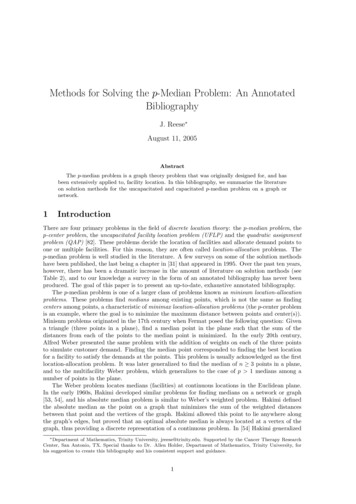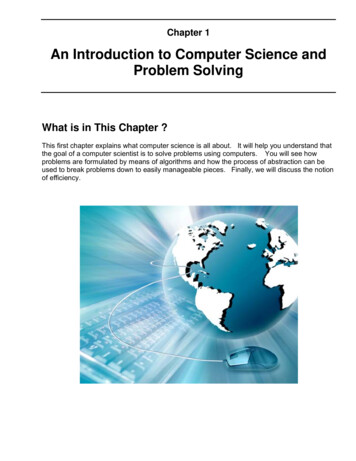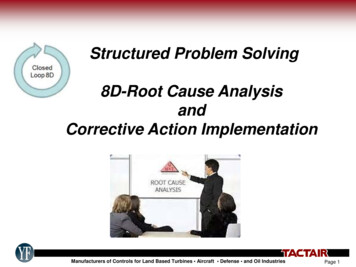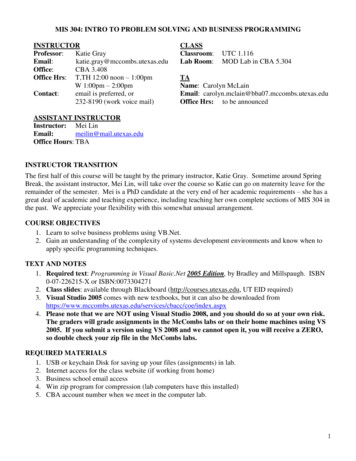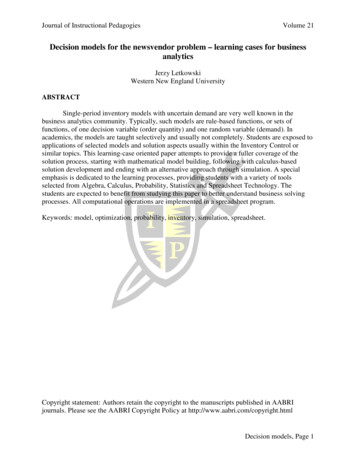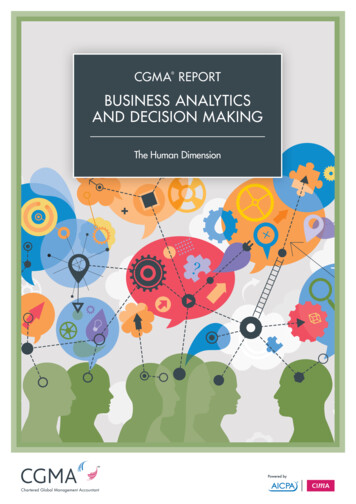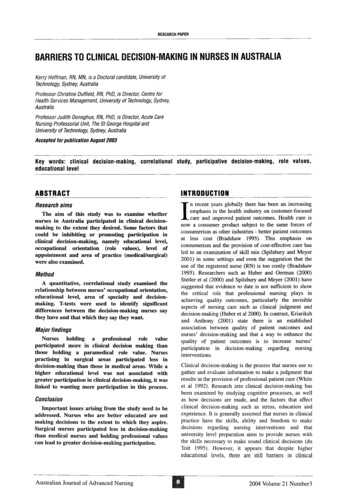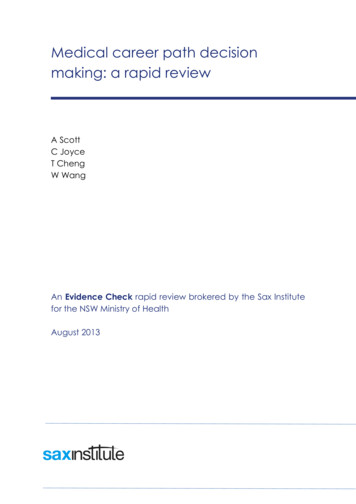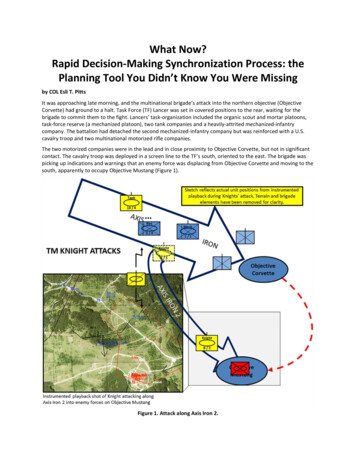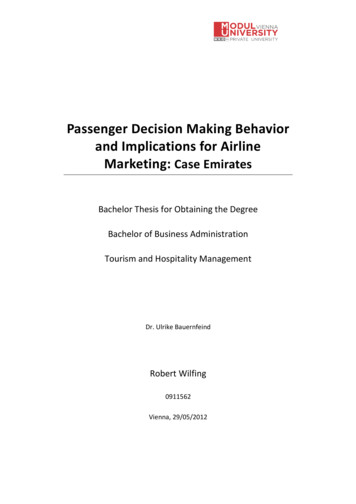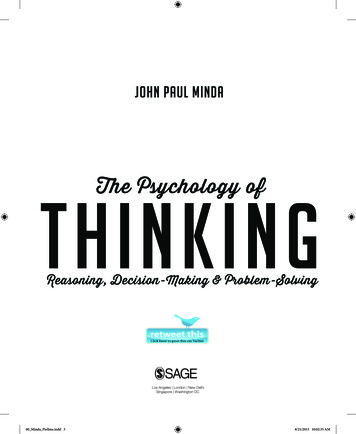
Transcription
Reasoning, Decision-Making & Problem-Solving00 Minda Prelims.indd 38/21/2015 10:02:35 AM
1THE PSYCHOLOGYOF THINKINGThinking is so central to the human experience that it has been described as the essenceof being. We are all familiar with the phrase, “Je pense donc je suis” or “I think thereforeI am.” This comes, of course, from Descartes’ Discourse on the Method (1637) and underscores what is so crucial and compelling about the study of thinking. Humans, like otheranimals, behave, learn, respond, communicate, and remember. But humans also think. Wecan discover something new by thinking about it. We can solve problems in the mind, visualize solutions, and arrive at an important decision by thinking. We can be aware of ourown thoughts and aware of the consequences of our actions and behaviours.This book is about the psychology of thinking. That might sound redundant, given thatpsychology is often defined as the study of the mind or of mental activity. In other words,if psychology is not about thinking, what else can it be about? Psychology is a very broadfield, encompassing everything from the study of neurotransmitters and basic neuroanatomy to the study of learning and memory to the understanding of mental health and thestudy of group behaviour. This book is concerned with the study and understandingof the thought process. Thinking is usually studied within the broader field of cognition. Cognitive psychology has traditionally been defined as the study of informationprocessing and behaviour. This encompasses everything from basic attention and perception to memory, concepts, and thinking. As a topic within the study of cognitive psychology,the psychology of thinking is concerned with complex mental behaviours, such as problemsolving, reasoning, decision-making, and becoming an expert. A good understanding of basiccognition is very useful in understanding the psychology of thinking, but it is not necessary. In other words, if you are reading this book as part of a course on thinking, a courseon reasoning and decision-making, or even a business or marketing course, and you havealready taken a course on cognition, then you may find some helpful overlap in some ofthe topics covered. But if you have not taken a course on cognition, I do not think youwill have any additional difficulty. I have tried to write this text so that it builds on prior01 Minda Ch 01 Section 1.indd 38/21/2015 10:01:42 AM
THE PSYCHOLOGY OF THINKINGknowledge, although that knowledge is not strictly necessary and you can enjoy and usethis book without any prior formal study in cognition.In this first chapter, I want to describe what thinking is (and also what it is not, forthe purposes of this book). I want to consider several examples of thinking, and severalchallenges to clear thinking. I will also describe some of the ways in which thinking hastraditionally been studied.WHAT IS THINKING?A basic descriptionThinking is mental activity, but it is not just any mental activity. Or rather, thinking andmental activity are not synonymous. For example, basic visual perception, memory consolidation, and coordination of sensory motor activity are all very sophisticated mental activities,but these kinds of behaviours are not usually considered to be thinking. Thinking is a veryspecific subset of mental activity that involves working with mental representations,planning and executing behaviours, and the coordination of cognitive resources.For example, solving an algebra problem, analyzing the themes in a film, discussing theprospects for your favourite sports team, or making a split-second decision about whichroute to take when a road is closed are all examples of thinking. Daydreaming, fantasy,depressive thoughts, and anxious ruminations are also examples of thinking, although inthis book I will deal primarily with thinking as a cognitive phenomenon and will spendless time considering the contents of unstructured thought or the clinical ramifications ofthoughts that are difficult to control.Different kinds of thinkingThinking can be divided up in many ways, including divisions based on content, effort, thedesired outcome, underlying cognitive processes, and function. These kinds of divisionsare intuitive but also allow researchers to study thinking at different levels. For example,we must make a distinction between the kind of thought that one engages in when solving an introductory physics problem and the kind of thought that one engages in whencatching a fly ball in baseball. For readers not immediately familiar with fly balls, a flyball is a ball that is hit with a high, slow arc. Catching one is fairly easy with practice andinvolves being able to predict exactly where the ball will land, and placing oneself in thatlocation (McBeath, Shaffer, & Kaiser, 1995). Solving a physics problem and catching afly ball both require attention and both have a measurable outcome (passing the exam orcatching the ball), and both are essentially physics problems. But solving an introductoryphysics problem requires sustained attention, the recall and generation of learned facts,the conscious application of those facts, and the ability to engage in some kind of explicit401 Minda Ch 01 Section 1.indd 48/21/2015 10:01:42 AM
The Psychology of Thinkingmonitoring of the behaviour. This is a conscious and effortful process, even if the solverin question has some experience with physics problems. Catching a fly ball, on the otherhand, is a process that often defies verbal description. It is intuitive and does not seem torely on the recall of facts, but rather on the replay of hand–eye coordination routines. Theseare both examples of complex thinking, and yet they differ in terms of what psychologicalprocesses are active during the execution. A thorough understanding of the psychology ofthinking requires being able to differentiate between these two kinds of thought processes,the cognitive processes that underlie them, and to be able to have an adequate theoreticaldescription of thinking that encompasses both kinds of thinking.Consider another example, the thinking processes behind a game of chess. Playingchess effectively requires the coordination of several cognitive processes and behaviours.One must have sufficient knowledge of the rules, a good recall of the rules, and the correctapplication of the rules. Playing chess, especially playing chess effectively, also involvesrecall for common chess positions and recall of previously played games of chess (Chase& Simon, 1973; De Groot, 1965). Playing chess effectively also involves thinking ahead,thinking about what your opponent might do, and developing a strategy for how to reactbased on what you think the other player will do. This second set of behaviours involveswhat is known as a theory of mind, which means being able to consider the contents ofanother person’s thoughts.Playing chess can be contrasted with playing a visually oriented video game. Manygames, especially the simple, action games found on mobile platforms such as “AngryBirds”, place much less emphasis on rule acquisition and retrieval of rules for memory, andplace a greater premium on procedurally learned motor responses. As with the previousexample (catching fly balls versus solving physics problems), the first behaviour is a conscious and effortful process whereas the second behaviour is an intuitive and proceduralprocess that defies verbal description. Interestingly, both rely on some degree of retrievedmemories. In the chapter on expertise in this text, we will discuss at length the degree towhich expert chess players rely on rapid retrieval of previously learned patterns. This mayshare some overlap with the kind of rapid retrieval of previously learned motor responsesinvolved in many visually oriented video games. So although these two kinds of thinkingare quite different in many ways, and solve different problems, there are shared underlyingmechanisms – in this case, retrieval of prior instances from memory.We could go on with many other examples, dissecting them to consider what principlesof thought and cognition are involved. Writing a paper for a course requires reading andretaining new ideas, considering more than one idea simultaneously, being able to examine the parallels and analogies among ideas, and being able to make use of basic linguisticprocesses to communicate the idea. Learning to play a short piece on the piano involves themapping of written notes to motor action, the focus of attention on the sound of the piece,and the coordination of several different motor behaviours. Diagnosing patients involves501 Minda Ch 01 Section 1.indd 58/21/2015 10:01:42 AM
THE PSYCHOLOGY OF THINKINGattending to symptoms, comparing the similarity of the observed symptoms to memoryrepresentations of previously seen patients. Looking over many of these examples, westart to see commonalities: focusing attention, making judgements about similarity, considering several ideas simultaneously. These common attributes will eventually becomethe objects of study for understanding the psychology of thinking.CHALLENGES TO THE THINKINGPROCESSThinking occurs on many levels and, as described above, different actions require different levels of thought. In fact, most of the time we either arrive at correct decisions or wearrive at decisions for which there was little cost for an incorrect decision. Furthermore,many researchers argue that humans are quite capable of predicting and judging information even in the face of incomplete and sparse information. For example, a recent study byTom Griffiths and Joshua Tenenbaum looked at people’s ability to make quick judgementsabout things that they were not experts in, such as how much money a movie might make,a person’s lifespan given a quick summary, or how long it takes to bake a cake (Griffiths& Tenenbaum, 2006). They found that most people were able to make predictions that fellclosely in line with statistical models of optimal outcome. In other words, people oftenmake really good judgements and predictions even if they are not exactly sure how orwhy they are doing it. A possible explanation is that people are very efficient at using theirexisting knowledge, memory, and understanding to fill in gaps and make quick predictions.But if you have ever arrived at the wrong conclusion, solved a problem incorrectly, ormade a bad decision, you’ve probably realized that thinking can sometimes be a challenge.We make mistakes. Sometimes we have to think about too many things at once, or we donot have all the information needed to arrive at a good decision. The section below considers some of the primary challenges that we face. We will consider many more “thinkingchallenges” later in this book.MultitaskingMultitasking is both commonplace and misunderstood. We know that multitasking refersto being able to do more than one thing at a time, like reading and listening to music,talking while cooking, checking Facebook during a lecture, texting and driving, etc. Thehuman brain and mind is designed to be able to divide attention and resources among several input and output channels (Pashler, 1994). What is challenging about understandingmultitasking is that most people are aware that it often occurs with some cost to behaviours but at the same time people often assume that it is a necessary action, a positive skill,or both. It would not be uncommon to hear someone claim to be “good at multitasking”.But is it really possible to be good at multitasking?601 Minda Ch 01 Section 1.indd 68/21/2015 10:01:42 AM
The Psychology of ThinkingCurrent research suggests that there is nearly always a cost, and that this cost mayeven last beyond the multitasking event. For example, Ophir, Nass, and Wagner (2009)created a questionnaire that allowed them to measure light, medium and heavy mediamultitaskers. In this case, media multitasking refers to using more than one media deviceor following more than one media stream at the same time. Examples might includestudying while watching a show on Netflix, or taking notes in class while checking aTwitter feed, or listening to music while reading. Heavy media multitaskers were thosewho were more than one full standard deviation above the average score on the questionnaire. Participants in the experiment were asked to engage in a number of tasks thatrequired them to switch quickly between responses and to detect targets in the presenceof distractors. If people were really good at multitasking, they might be expected to dowell at a task like this, because good performance relies on the ability to switch quicklyand to screen out irrelevant information.This was not the finding, however. Being a heavy media multitasker did not seem topredict better performance on these cognitive tasks. In fact, the researchers found theopposite pattern. They found that heavy or “chronic” media multitaskers performed worseon a test of task-switching ability, likely due to a reduced ability to filter out interferencefrom the irrelevant task set. In other words, the very people who were the heaviest multitaskers and who should have been “good at multitasking” were not really very goodat all, and they actually performed worse on a test of actual multitasking. One possibleexplanation for this counterintuitive result is that heavy media multitaskers have adoptedan attentional style that results in greater distractibility. In other words, instead of beingbetter at selectively attending and screening out, heavy media multitaskers were worsebecause they were constantly switching and being distracted. This does not mean thatmedia multitaskers will suffer on all tasks, but it does suggest that multitasking may notalways be a benefit.BOX 1.1One of the most prevalent things in many of our lives is the smartphone. For thoseof us that use or rely on a smartphone, we know the challenges that it presents,and the relative costs and benefits. Without getting into
retaining new ideas, considering more than one idea simultaneously, being able to exam- ine the parallels and analogies among ideas, and being able to make use of basic linguistic processes to communicate the idea. Learning to play a short piece on the piano involves the mapping of written notes to motor action, the focus of attention on the sound of the piece, and the coordination of several .
